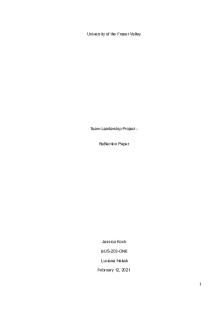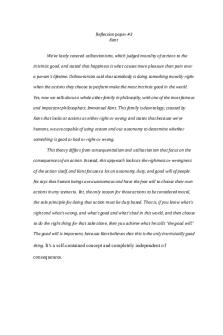Reflection Paper III Panganiban Meaning OF THE Church PDF

| Title | Reflection Paper III Panganiban Meaning OF THE Church |
|---|---|
| Course | Theology |
| Institution | Pontifical and Royal University of Santo Tomas, The Catholic University of the Philippines |
| Pages | 2 |
| File Size | 120.2 KB |
| File Type | |
| Total Downloads | 56 |
| Total Views | 130 |
Summary
A paper on the meaning of the Church...
Description
Page | 1
Page 1 UST FACULTY OF SACRED THEOLOGY Name: Professor: S.Th.D.
Panganiban, Kendrick Ivan B., M.A. Theo., M.A. Past. Min. Rev. Fr. Cecilio Vladimir E. Magboo, O.P.,
Course: S.Th. 702 – Church Reform, Church Unity and Vatican II
Reflection Paper III MEANING OF THE CHURCH While reflecting on this topic, I remembered a debate I have heard between one of the Catholic Faith Defenders (CFD) and one of the pastors of the Iglesia ni Cristo (INC) sect. In that debate, the INC pastor argued over the point that Felix Manalo interpreted the Biblical understanding of the “Church” as a communion of the elect that does not need a hierarchy that we in the Catholic Church have like having priests, bishops and nuns, etc. To that, the CFD member’s response was quite simple: “the Gospel was very clear on the true Church – Christ offered the Last Supper with his disciples, who in turn became the apostles at Pentecost, who in turn became the seeds that built the Church. Hence, if you are going to ask me, your sect is not the Iglesia ni Cristo. We are the true Iglesia founded by Christ. One that has been on this earth for more than 2000 years”. Saying “We are the true Church” corresponds to asking next, “What do we mean by being Church?”. We have a large sum of meanings if we are going to see the Catechism of the Catholic Church, nos. 751 to 780. Of course, we could rely on the basic definition of ecclesia (Latin) or ekklesia (Greek) as “assembly”. After all Vatican II’s Lumen Gentium declares that, “He planned to assemble in the holy Church all those who would believe in Christ”. 1 The next question to this would be, “What is the point of gathering as an assembly?” Taking the cue from my M.A. Systematic Theology thesis entitled The Role of Catholic Marian Shrines in the Diocese of Malolos in View of the New Evangelization: A Theologico-Pastoral Assessment, I was instructed to provide a brief introduction into what New Evangelization 1 Second Vatican Ecumenical Council, Dogmatic Constitution on the Church, Lumen Gentium, 21 November, 1964, no. 2.
Page | 2
Page 2 UST FACULTY OF SACRED THEOLOGY is all about. Upon further reading for this, I chanced upon Avery Cardinal Dulles, S.J.’s account in the book “John Paul II and the New Evangelization”. There, he noticed how ressourcement refers to a “return to the authoritative sources” of the Catholic faith, for which comes the purpose of rediscovering the true meaning of ecclesial life in light of the signs of the times. Here, Dulles noted how during Vatican I (1869-1870), the term “Gospel” ( evangelium) was never even used in any document. Yet less than a century later, Vatican II (1962-1965) mentioned “Gospel” 157 times, along with “evangelize” 18 times, and “evangelization” 31 times. 2 Although the sixteen documents of Vatican II spoke of the need for evangelization, only the Pastoral Constitution on the Church in the Modern World spoke of it in such a way that there is a need which the Church of the present time is called on to address . It mentions of “the ability to express Christ’s message in its own way is developed in each nation, and at the same time there is fostered a living exchange between the Church and diverse cultures of people”.3 Now going back to the question: ““What is the point of the gathering as an assembly?”, we answer that the purpose of the Church is to proclaim the Gospel to the believers of Christ. Vatican II, thus, became a turning point for the Church which has seen how we should understand ecclesial life. Ecclesial life is about being a pilgrim people of God on a journey to Christ himself. This is made possible through the Word of God and the Sacrament, which would allow us to understand Christ and become his chosen people. The Church is both the historical institution stretching two millennia and also the People of God inspired by the Holy Spirit.
2 Fr. Avery Cardinal Dulles, S.J., “John Paul II and the New Evangelization: What does it Mean?” in John Paul II and the New Evangelization, ed. by Ralph Martin and Peter Williamson (San Francisco: Ignatius Press, 1995), 26. 3 Second Vatican Council, Pastoral Constitution on the Church in the Modern World, Gaudium et Spes, 7 December, 1965, no. 44....
Similar Free PDFs

The Meaning of Property
- 6 Pages

Into the Woods Reflection Paper
- 3 Pages

Homophobia & the black church
- 8 Pages

Reflection Paper
- 2 Pages

Reflection Paper
- 4 Pages

Reflection Paper
- 2 Pages

Meaning of the Term Base
- 3 Pages

Reflection paper
- 3 Pages
Popular Institutions
- Tinajero National High School - Annex
- Politeknik Caltex Riau
- Yokohama City University
- SGT University
- University of Al-Qadisiyah
- Divine Word College of Vigan
- Techniek College Rotterdam
- Universidade de Santiago
- Universiti Teknologi MARA Cawangan Johor Kampus Pasir Gudang
- Poltekkes Kemenkes Yogyakarta
- Baguio City National High School
- Colegio san marcos
- preparatoria uno
- Centro de Bachillerato Tecnológico Industrial y de Servicios No. 107
- Dalian Maritime University
- Quang Trung Secondary School
- Colegio Tecnológico en Informática
- Corporación Regional de Educación Superior
- Grupo CEDVA
- Dar Al Uloom University
- Centro de Estudios Preuniversitarios de la Universidad Nacional de Ingeniería
- 上智大学
- Aakash International School, Nuna Majara
- San Felipe Neri Catholic School
- Kang Chiao International School - New Taipei City
- Misamis Occidental National High School
- Institución Educativa Escuela Normal Juan Ladrilleros
- Kolehiyo ng Pantukan
- Batanes State College
- Instituto Continental
- Sekolah Menengah Kejuruan Kesehatan Kaltara (Tarakan)
- Colegio de La Inmaculada Concepcion - Cebu







